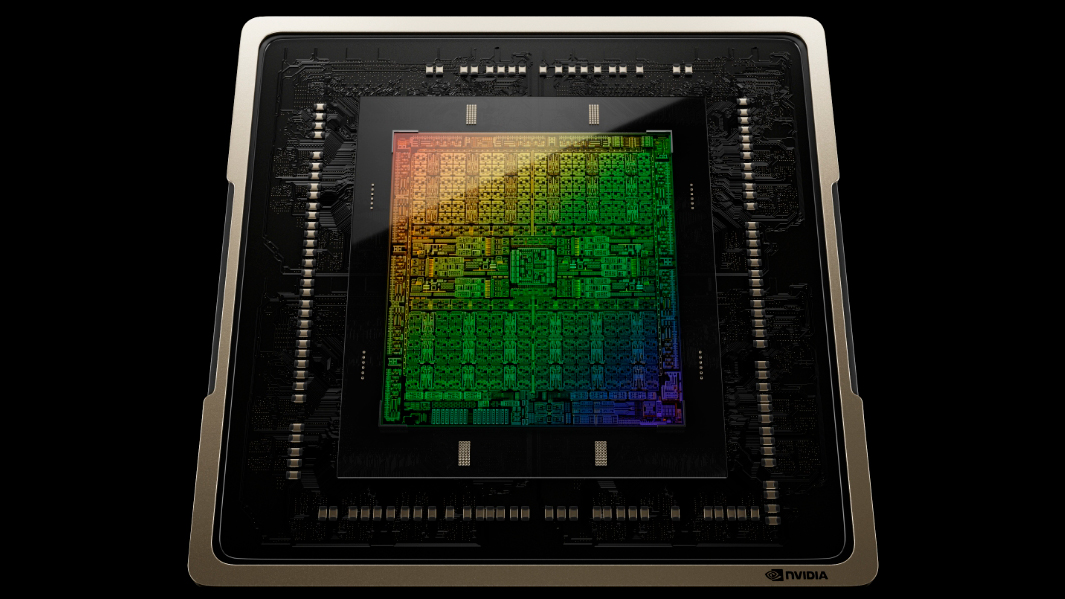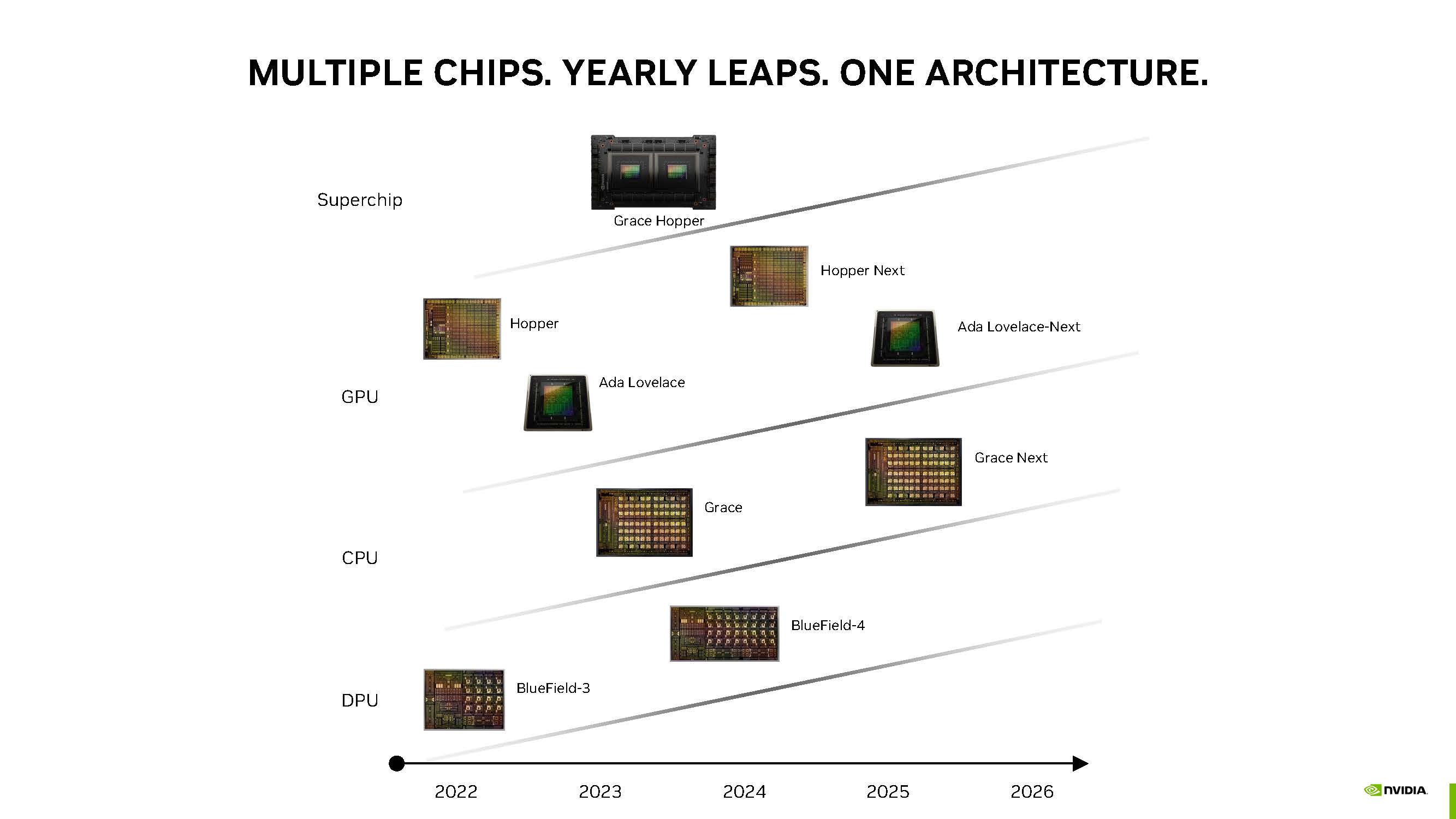Nvidia Ada Lovelace Successor GPUs Slated for 2025 Release

As a demonstration of the Nvidia H100's (Hopper) AI training prowess, an army of only 3,584 Hopper GPUs trained a GPT-3-based model in just 11 minutes. During that press briefing, Nvidia shared an updated roadmap detailing the company's next-generation products, including the successor to the GeForce RTX 40-series Ada Lovelace GPUs, some of the best graphics cards for gaming available today.
According to the roadmap, Nvidia plans to unleash "Ada Lovelace-Next" graphics cards in 2025. Assuming the chipmaker continues with the current naming scheme, the next-generation GeForce products should hit the market as the GeForce RTX 50 series. For obvious reasons, Nvidia didn't reveal the codename for Ada Lovelace's successor. Some believe it could be Blackwell, a familiar codename from the Nvidia hack. However, we think Blackwell is likely the successor to Hopper, which Nvidia has labeled as "Hopper Next" on the roadmap.
Nvidia has typically adhered to a two-year cadence for consumer graphics cards. For instance, the chipmaker launched Pascal in 2016, Turing in 2018, Ampere in 2020, and not so long ago, Ada Lovelace in 2022. If Nvidia launches Ada Lovelace's successor in 2025, the company would be breaking the usual rhythm and pushing the cadence closer to three years, or 30 months if the chipmaker aims for an early 2025 release.
That said, Nvidia's AI business is flourishing. The recent AI trend has generated significant demand for Nvidia's GPUs, such as the latest H100 or the previous-generation A100. ByteDance has reportedly ordered $1 billion worth of Nvidia GPUs just this year. Despite the export restrictions, Nvidia has continued to grow its AI business in China, one of the world's biggest markets. The restrictions have forced Nvidia to nerf some of its best AI products and release particular SKUs like the H800 or A800 to meet the export requirements.
But let's look at it in another way. The export regulations have favored Nvidia since it means the chipmaker's customers must buy more GPUs to get the equivalent performance from the vanilla variants.
It's understandable why Nvidia may prioritize compute GPU production over gaming GPUs. A recent report claims that the chipmaker has allegedly increased the production of its compute GPU products. Nvidia isn't facing tough competition from AMD's RDNA 3 product stack, and Intel doesn't currently pose a serious threat to the GPU duopoly. In other words, Nvidia has the luxury of procrastinating a bit on the consumer side.
Nvidia recently expanded its GeForce RTX 40-series product stack to (or at least close to) the bottom of the ladder with the GeForce RTX 4060 and GeForce RTX 4060 Ti. There's the potential for a GeForce RTX 4050 as well as additional options at the top like an RTX 4080 Ti or GeForce RTX 4090 Ti. Nvidia could also offer up a Titan RTX Ada. The ongoing leaks of an Nvidia quad-slot cooler suggest that at least one of these monsters exists.
And if push ever comes to shove, Nvidia could always take a play out of its old Turing playbook and refresh Ada Lovelace, giving it the 'Super' treatment, extending its Ada lineup even further. But one thing seems clear: No one should expect a true follow-up to the Lovelace architecture anytime this year or next.
Get Tom's Hardware's best news and in-depth reviews, straight to your inbox.

Zhiye Liu is a news editor, memory reviewer, and SSD tester at Tom’s Hardware. Although he loves everything that’s hardware, he has a soft spot for CPUs, GPUs, and RAM.
-
Reply
For obvious reasons, Nvidia didn't reveal the codename for Ada Lovelace's successor. Some believe it could be Blackwell, a familiar codename from the Nvidia hack. However, we think Blackwell is likely the successor to Hopper, which Nvidia has labeled as "Hopper Next" on the roadmap.
Yeah, Blackwell is most likely to be an HPC and AI-only GPU architecture. The successor to Ada Lovelace is currently labeled as 'Ada Lovelace-Next' , so that should come a year later in 2025.
So the most obvious guess would be that Nvidia can release the AD103, AD104, & AD106 chips with higher core counts and higher VRAM as either a "Ti" or a "SUPER" refresh.
Let's not count AD102 GPU die here, because the green team already have the fastest card around, the RTX 4090, and due to no competition in this segment, there is no need to launch the RTX 4090 Ti at the moment.
But maybe when AMD's RDNA 4 Radeon RX 8000 series cards arrive ?
Also, since the RTX 4080 and 4060 Ti both utilize a cut-down chip, AD103 and AD106 die, there might be a possibility that these chips can be used in the full-fat version as well. Obviously, with faster clocks and faster memory dies to make for a decent refresher in mid-2024 before the company rolls out its brand-new architecture for gamers in 2025.
Keep Pressing F5 for refresh ! -
Amdlova with the price of silicon too high... waiting will be good for consumer... maybe use intel new fabsReply -
Fantastic news! That means 4090 is gonna last even longer in high-end gaming! Which makes it an even better investment!Reply
Nvidia, is more than dominant in the GPU market, and it shows. No need to rush, when there's no competition. -
bit_user Meanwhile, AMD could do a RDNA3 refresh on N4. I'm not saying they will, but it seems like a relatively low-cost option for them to improve their competitiveness without a wholesale new generation.Reply
TBH, I was kinda hoping they would do that with Zen4, also. Release a Zen4+, late this year, to counter Raptor Refresh and Emerald Rapids. They could hopefully improve their heatspreader situation, while they're at it.
Being realistic, AMD is getting beaten up so badly in the consumer market that it's hard to see how any near-term investment would be justified. More likely, we'll just see continued focus on drivers and AI. -
Photonaxon AI is just a marketing (BS) fad, like cloud computing a few years back. If you think AI is real, you don't know much about computing.Reply -
watzupken This shows a few things,Reply
1. Gaming market is secondary if not tertiary to Nvidia - this is the same story during the mining craze where all GPUs and focus was diverted to miners. The prove is really post the mining craze, there was a flood of GPUs that still remained unsold till now, which means that the supply has always been there, but just diverted to miners through the back door. The light hash rate bifurcation is just a facade.
2. Lack of competition - AMD and Intel are just too uncompetitive. AMD in particular tends to try and solve the problem by dropping price which is great. But the perception of less stable driver persist. And to be honest, it is factual given that there are known day 1 issues that still remains on their “known issue” list even till now.
The PC gaming market is in my opinion, slowly dying. What was previously an affordable gaming platform is no longer the case. Understand that it costs more to produce anything now, but does not negate the fact that it is getting costly to game on PC. The better hardware is also immediately negated by the burden of the OS and games that is so taxing. I think it is a record that the flagship GPU, the RTX 4090 in this case, already struggles to deliver to 60 FPS at native 4K in some of the new rebooted titles within 6 months. Stretching it to 3 years for a refresh is not going to help. And I do expect whatever replacement in 2025 will run into the same problem, on top of increasing cost. At the lower end that can benefit from a newer and better GPU architecture, instead now we get planned obsolescence by means of limiting VRAM/ memory bus, on top of higher cost for the higher performance. -
watzupken Reply
The problem is that AMD don’t seems to be tackling the issue that most gamers are concern, and that is their driver. The media don’t help either because a lot of them are likely paid to try and paint a very bad picture of the driver and FSR. In reality, as a user of AMD GPUs now and then, I rarely find teething issues, and FSR generally works ok for me. Visual artefacts are there, but it wasn’t terrible in my opinion, when you are considering between dropping graphic settings or just switching on FSR to maintain a level of FPS on older GPUs. It is not that AMD drivers are close to perfect because it is very clear they are behind Nvidia. Things like higher idle power for example have been on their “known issues” list for a long time, but still sits there for whatever reasons 6 to 7 months after the product release. While annoying, it does not affect the performance of games.bit_user said:Meanwhile, AMD could do a RDNA3 refresh on N4. I'm not saying they will, but it seems like a relatively low-cost option for them to improve their competitiveness without a wholesale new generation.
TBH, I was kinda hoping they would do that with Zen4, also. Release a Zen4+, late this year, to counter Raptor Refresh and Emerald Rapids. They could hopefully improve their heatspreader situation, while they're at it.
Being realistic, AMD is getting beaten up so badly in the consumer market that it's hard to see how any near-term investment would be justified. More likely, we'll just see continued focus on drivers and AI. -
Amdlova The amd sell well on third world... but with this launch "RX 7600" who drooped the prices one day before... make the people holding the wallet. AMD has the inferior product, make some people rage about that. Here the rx 7600 have price point of 400$ in some weeks will be at 300$ or ever lower. Why spend money in something you will lost 50% of value in weeks. For other hand every nvidia card has the value unchanged over months.Reply
I'am waiting the 4060 review before decide where to throw the wallet. -
AgentBirdnest Reply
I haven't followed CPU news too closely lately... is there some kind of flaw with the heatspreader, or do you just mean the "spider leg" design being kinda annoying?bit_user said:TBH, I was kinda hoping they would do that with Zen4, also. Release a Zen4+, late this year, to counter Raptor Refresh and Emerald Rapids. They could hopefully improve their heatspreader situation, while they're at it.
edit: In regards to the article, I hope this means we'll see something like a "Super" refresh later this year. 4080 Super could use the weak AD102 dies, 4070 Super could use AD103...
A guy can dream. : P I was planning to get a new GPU earlier this year, but some other expenses got in the way. I'll probably afford one around the holidays, and am hoping that waiting patiently might let me get a better card for the money. If not, either way, I'll still get a video card and be really happy with it. -
bit_user Reply
Like cloud computing? Sure, let's go with that.Photonaxon said:AI is just a marketing (BS) fad, like cloud computing a few years back.
